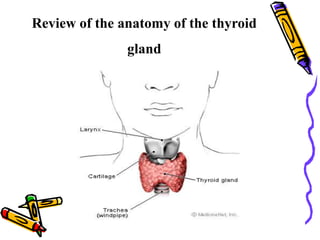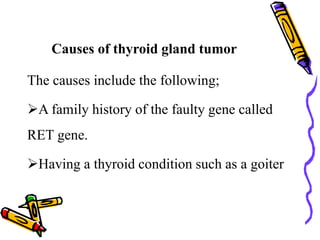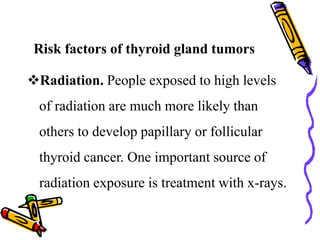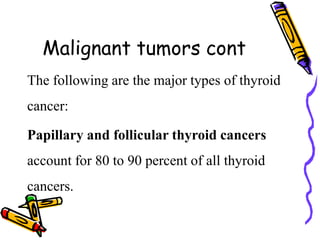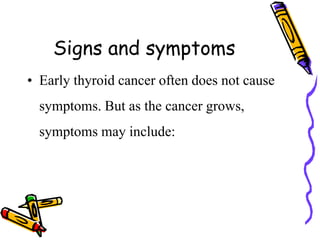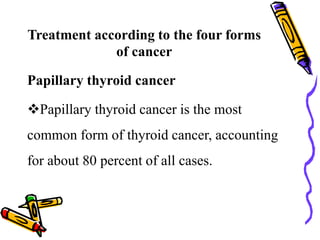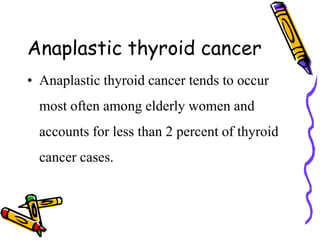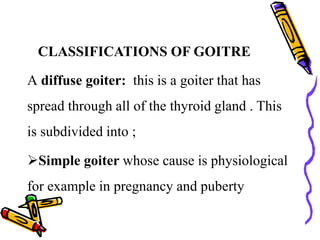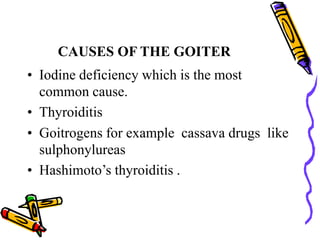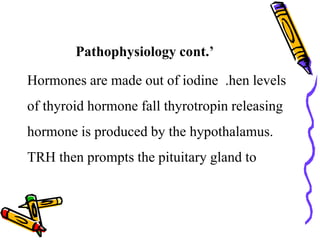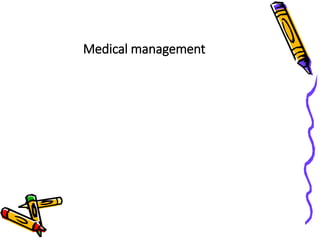tumors of the thyroid gland Taonga - Copy (2).ppt
- 1. Tumors of the thyroid gland RN Third year student Taonga Mvula
- 2. Introduction • The thyroid is a gland in the neck. • It has two kinds of cells that make hormones. • Follicular cells make thyroid hormone, which affects heart rate, body temperature,
- 3. Introduction cont and energy level. •C cells make calcitonin, a hormone that helps control the level of calcium in the blood.
- 4. Introduction cont • The thyroid is shaped like a butterfly and lies at the front of the neck, beneath the voice box (larynx). • It has two parts, or lobes.
- 5. Introduction cont • The two lobes are separated by a thin section called the isthmus. • A healthy thyroid is a little larger than a quarter. • It usually cannot be felt through the skin.
- 6. Introduction cont • A swollen lobe might look or feel like a lump in the front of the neck. • A swollen thyroid is called a goiter. Most goiters are caused by not enough iodine in the diet.
- 7. Introduction cont • Iodine is a substance found in shellfish and iodized salt which is necessary for the normal function of the thyroid gland
- 8. General Objective At the end of this presentation, third year student nurses should gain knowledge and understanding on thyroid gland tumors and how to manage them.
- 9. Specific Objectives At the end of the presentation third year student nurses should be able to ; Outline the anatomy of the thyroid gland. Define terms used in the presentation.
- 10. Specific Objectives cont’ list the causes of the tumors and goiter. State the types of tumors Explain the pathophysiology State the signs and symptoms
- 11. Specific Objectives cont’ Explain the surgical management Explain the nursing management Outline the preventive measures State the complications
- 12. Review of the anatomy of the thyroid gland
- 13. Definition • Tumor of the thyroid gland is a growth in the thyroid gland which can be either benign or malignant. • Thyroid tumors are either benign (noncancerous) or malignant (cancerous) growths.
- 14. Definition cont’ • Examples of benign tumors are adenomas, which secrete thyroid hormone. • Malignant tumors are more rare and are more common in women than in men.
- 15. Causes of thyroid gland tumor The causes include the following; A family history of the faulty gene called RET gene. Having a thyroid condition such as a goiter
- 16. Risk factors of thyroid gland tumors Radiation. People exposed to high levels of radiation are much more likely than others to develop papillary or follicular thyroid cancer. One important source of radiation exposure is treatment with x-rays.
- 17. Risk factors of thyroid gland tumors cont’ Family history. Medullary thyroid cancer can be caused by a change, or alteration, in a gene called RET. The altered RET gene can be passed from parent to child. Nearly everyone with the altered RET gene will develop Medullary thyroid cancer.
- 18. Risk factors of thyroid gland tumors cont’ A blood test can detect an altered RET gene Doctors may recommend frequent lab tests or surgery to remove the thyroid before cancer develops.
- 19. Risk factors of thyroid gland tumors cont’ When medullary thyroid cancer runs in a family, the doctor may call this "familial medullary thyroid cancer" or "multiple endocrine neoplasia (MEN) syndrome."
- 20. Risk factors of thyroid gland tumors cont’ • Being female. In the United States, women are two to three times more likely than men to develop thyroid cancer. • Age. Most patients with thyroid cancer are more than 40 years old. People with anaplastic thyroid cancer are usually more than 65 years old.
- 21. Benign tumors of the thyroid gland • Benign nodules are not cancer. • Cells from benign nodules do not spread to other parts of the body.
- 22. Benign tumors of the thyroid gland cont’ • They are usually not a threat to life. • Most thyroid nodules (more than 90 percent) are benign
- 23. Thyroid adenomas • Thyroid adenomas grow from the cell layer that lines the inner surface of the thyroid gland. • The adenoma itself secretes thyroid hormone.
- 24. Thyroid adenomas cont’ • If the adenoma secretes enough thyroid hormone, it may cause hyperthyroidism. • Thyroid adenomas may be treated if they cause hyperthyroidism.
- 25. Thyroid adenomas cont’ • Treatment may include surgery to remove part of the thyroid (the overactive nodule).
- 26. Malignant tumors • Malignant nodules are cancer. • They are generally more serious and may sometimes be life threatening. • Cancer cells can invade and damage nearby tissues and organs.
- 27. Malignant tumors cont’ • Also, cancer cells can break away from a malignant nodule and enter the bloodstream or the lymphatic system. • That is how cancer spreads from the original cancer (primary tumor) to form new tumors in other organs.
- 28. Malignant tumors cont The following are the major types of thyroid cancer: Papillary and follicular thyroid cancers account for 80 to 90 percent of all thyroid cancers.
- 29. Both types begin in the follicular cells of the thyroid. Most papillary and follicular thyroid cancers tend to grow slowly. If they are detected early, most can be treated successfully.
- 30. Malignant tumors cont Medullary thyroid cancer accounts for 5 to 10 percent of thyroid cancer cases. It arises in C cells, not follicular cells. Medullary thyroid cancer is easier to control if it is found and treated before it spreads to other parts of the body.
- 31. Malignant tumors cont Anaplastic thyroid cancer is the least common type of thyroid cancer (only 1 to 2 percent of cases). It arises in the follicular cells.
- 32. The cancer cells are highly abnormal and difficult to recognize. This type of cancer is usually very hard to control because the cancer cells tend to grow and spread very quickly.
- 33. Malignant tumors cont • If thyroid cancer spreads (metastasizes) outside the thyroid, cancer cells are often found in nearby lymph nodes, nerves, or blood vessels.
- 34. • If the cancer has reached these lymph nodes, cancer cells may have also spread to other lymph nodes or to other organs, such as the lungs or bones.
- 35. Malignant tumors cont • When cancer spreads from its original place to another part of the body, the new tumor has the same kind of abnormal cells and the same name as the primary tumor. • For example, if thyroid cancer spreads to
- 36. • the lungs, the cancer cells in the lungs are thyroid cancer cells. • The disease is metastatic thyroid cancer, not lung cancer. • It is treated as thyroid cancer, not as lung cancer
- 37. Signs and symptoms • Early thyroid cancer often does not cause symptoms. But as the cancer grows, symptoms may include:
- 38. • A lump, or nodule, in the front of the neck near the Adam's apple; • Hoarseness or difficulty speaking in a normal voice • Swollen lymph nodes, especially in the neck
- 39. Signs and symptoms cont • Difficulty swallowing or breathing; or • Pain in the throat or neck. • These symptoms are not sure signs of thyroid cancer. An infection, a benign goiter, or another problem also could cause these symptoms.
- 40. Diagnosis of thyroid cancer • Complete medical history and • Medical examination, • Other diagnostic procedures for thyroid cancer may include:
- 41. RADIOLOGY •thyroid scan •ultrasound of the neck
- 42. LABORATORY •biopsy - taking a sample of the nodule with a needle for examination under a microscope
- 43. Treatment according to the four forms of cancer Papillary thyroid cancer Papillary thyroid cancer is the most common form of thyroid cancer, accounting for about 80 percent of all cases.
- 44. This form of thyroid cancer affects more women than men. Treatment for papillary cancer usually involves:
- 45. Papillary thyroid cancer cont surgery - to remove part or all of the thyroid (called a thyroidectomy) thyroid hormone therapy - to suppress the pituitary gland from secreting more
- 46. thyroid-stimulating hormone, which may stimulate a recurrence of papillary cancer administration of radioactive iodine - to destroy any remaining thyroid tissue
- 47. Follicular thyroid cancer • Follicular thyroid cancer occurs most often among elderly patients and accounts for about 10 percent of thyroid cancer cases. This type of thyroid cancer is more aggressive and tends to spread through the
- 48. bloodstream to other parts of the body Treatment for follicular cancer may include surgery - to remove the thyroid gland (thyroidectomy)
- 49. Anaplastic thyroid cancer • Anaplastic thyroid cancer tends to occur most often among elderly women and accounts for less than 2 percent of thyroid cancer cases.
- 50. This quick-growing cancer usually results in a large growth in the neck. Many patients diagnosed with anaplastic thyroid cancer may die within one year of diagnosis.
- 51. Follicular thyroid cancer cont • administration of radioactive iodine - to destroy any remaining thyroid tissue
- 52. Medullary thyroid cancer • Medullary thyroid cancer tends to spread through the lymphatic system and the bloodstream to other parts of the body. This type of cancer produces excessive amounts of calcitonin, a hormone also produced by the thyroid gland itself.
- 53. Anaplastic thyroid cancer cont Treatment for anaplastic thyroid cancer may include: surgery - to remove the thyroid gland (thyroidectomy) medication (i.e., anticancer drugs) radiation therapy
- 54. Medullary thyroid cancer cont • surgery - to remove the thyroid gland (thyroidectomy) • Additional surgery may be necessary if the cancer has spread. • Because medullary cancer tends to run in families, screening tests for family members
- 55. GOITRE This is defined a any enlargement of the thyroid gland with or without increase secretion of thyroid hormones
- 56. CLASSIFICATIONS OF GOITRE A diffuse goiter: this is a goiter that has spread through all of the thyroid gland . This is subdivided into ; Simple goiter whose cause is physiological for example in pregnancy and puberty
- 57. CLASSIFICATIONS OF GOITRE cont’ graves disease and hashimoto’s disease which are said to b caused by autoimmunity
- 58. CLASSIFICATIONS OF GOITRE cont’ Non toxic goiter is associated with low or normal thyroid levels. Toxic goiter refers to goiter with hyperthyroidism mostly due to graves disease
- 59. CAUSES OF THE GOITER • Iodine deficiency which is the most common cause. • Thyroiditis • Goitrogens for example cassava drugs like sulphonylureas • Hashimoto’s thyroiditis .
- 60. Pathophysiology Iodine is necessary for the synthesis of the thyroid hormones thyroxin (T4) and triiodothyronine (T3). In endemic goiter, iodine deficiency leaves the thyroid gland un able to produce its hormones because the
- 61. Pathophysiology cont.’ Hormones are made out of iodine .hen levels of thyroid hormone fall thyrotropin releasing hormone is produced by the hypothalamus. TRH then prompts the pituitary gland to
- 62. Pathophysiology cont’ make thyroid stimulating hormone or thyrotropin which stimulates production of T4 and T3 . It also causes the thyroid gland to grow in size by increasing cell division
- 63. Signs and Symptoms • Long standing neck swelling • Painless swelling • Dyspnea and dyphagia • Hoarseness of voice











